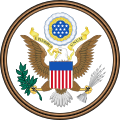| Coat of arms of the State of New York | |
|---|---|
 | |
| Versions | |
 Great Seal of the State of New York | |
| Armiger | State of New York |
| Adopted | 1882, modified 1896, 1901, and 2020 |
| Crest | An American eagle with wings displayed, surmounting a globe displaying the Atlantic hemisphere |
| Shield | Azure, in a landscape, the sun in fess, rising in splendor a river, bordered below by a grassy shore fringed with shrubs, all proper. |
| Supporters | Liberty and Justice |
| Motto | Excelsior E Pluribus Unum |
 | |
| Use | Civil and state flag |
|---|---|
| Proportion | 1:2 |
| Adopted | April 2, 1901 (modified in April 2020) |
| Design | A state coat of arms on a blue field. |
| Flag of the governor of New York | |
 | |
| Proportion | 3:5 |
The coat of arms of the U.S. state of New York was formally adopted in 1778, and appears as a component of the state's flag and seal.
Contents

The shield displays a masted ship and a sloop on the Hudson River (symbols of inland and foreign commerce), bordered by a grassy shore and a mountain range in the background with the smiling sun rising behind it. The unheraldic nature of the Hudson River landscape reveals the modern origin of the design.
The shield has two supporters:
- Left: Liberty, with the Revolutionary imagery of a Phrygian cap raised on a pole. Her left foot treads upon a crown, representing the state's independence from the British monarchy that ruled colonial New York.
- Right: Justice, wearing a blindfold (representing impartiality) and holding scales (representing fairness) and the sword of justice.
A banner below the shield shows the motto Excelsior , a Latin word meaning "higher", "superior", "lordly", commonly translated as "Ever Upward." Following the adoption of the 2021 State Budget in April 2020, a secondary motto, E pluribus unum, appears. [1] [2]
Flags bearing the pre-2020 coat of arms (i.e. without the motto E pluribus unum) are still widely used and de facto valid, so long as serviceable.
The shield is surmounted by a crest consisting of an eagle surmounting a world globe.
The flag of New York is the coat of arms on a solid blue background and the state seal of New York is the coat of arms surrounded by the words "The Great Seal of the State of New York." It is one of nine U.S. state flags to feature an eagle, alongside those of Illinois, Iowa, Michigan, Missouri, North Dakota, Oregon, Pennsylvania and Wyoming.












